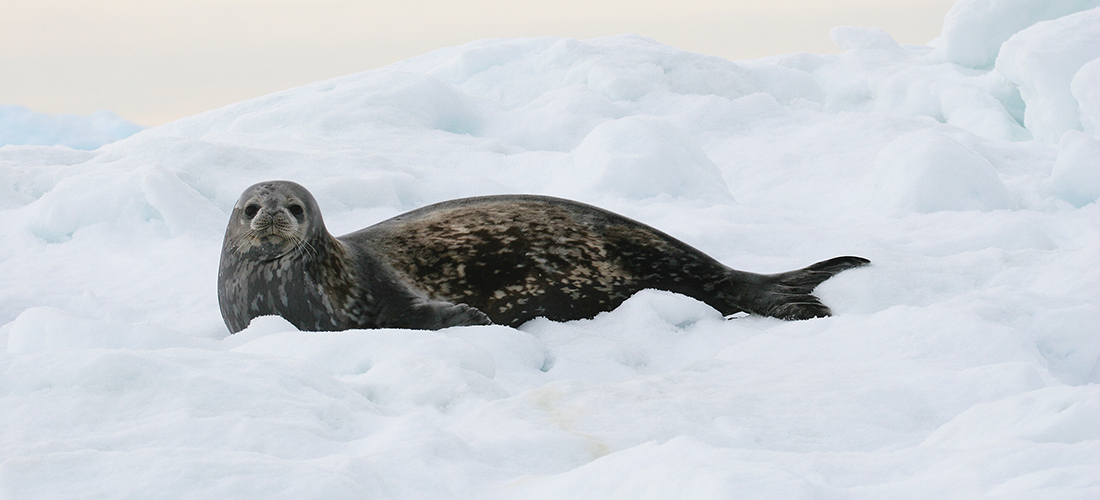
Todd Pusser’s magical photos are a portrait of our wild and endangered world
By Jim Moriarty • Photographs by Todd Pusser
If you’re going to photograph something as low as a snake’s belly in a wagon rut, you have to get right down there with it so it’s no surprise to find Todd Pusser stretched out on his stomach somewhere in the Sonoran Desert, nose-to-nose with a snake at sun up. That may not be your idea of a good time but, to him, it’s hog — or maybe Gila monster — heaven. At its best, photography isn’t about pushing a button, it’s about pulling on heartstrings, even if the subject is a bit cold-blooded.
One of the 44-year-old Pusser’s exploring buddies is Gary Williamson, a 73-year-old retired Virginia state park ranger. “I love the way he would compose his shots,” says Williamson. “We’d see a snake stretched out and, if it was late in the day and there was a pretty sunset starting to form, he would lay right down with the sunset in the background and the snake in the foreground, whether it was a harmless snake or a venomous snake. Instead of just a close-up, he’ll have the habitat in the background. He has one of a scarlet kingsnake in burned pinewoods in South Carolina. It shows the burned ground and the tall longleaf pines and a beautiful scarlet kingsnake on a charred log. To me, those kind of photographs are far superior to just a close-up of an animal. Todd’s pictures really tell a story.”
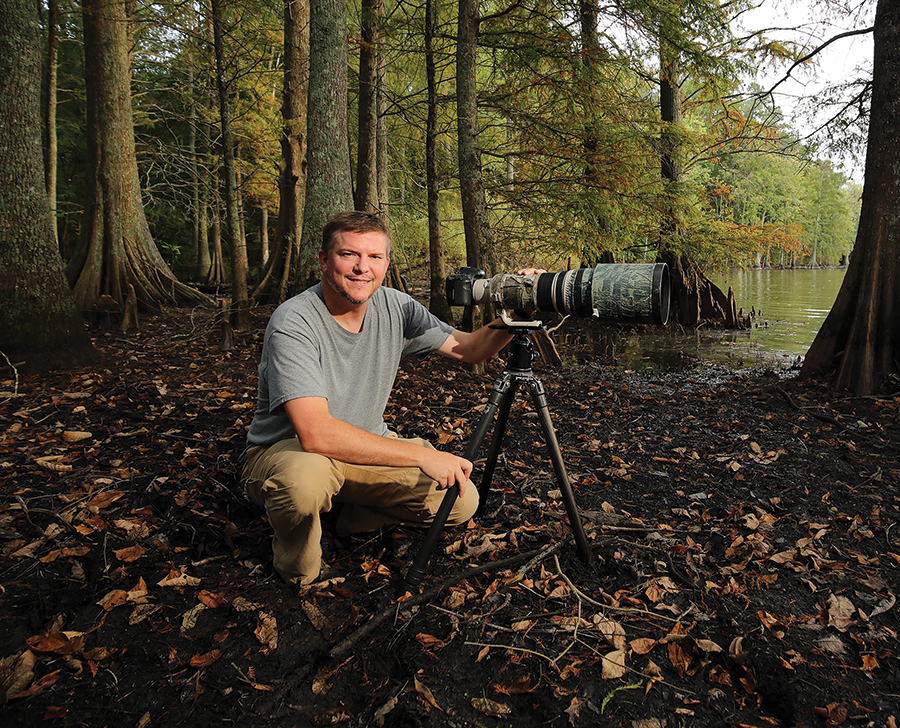
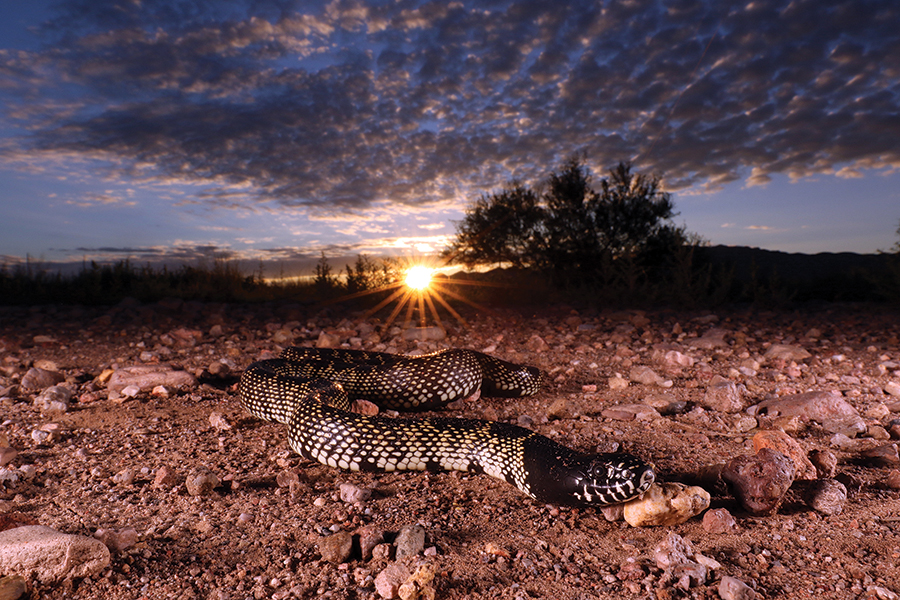
That story begins with a paper and pencil and a bucket of glue. With their closest neighbor a mile away, the adopted son of Larry and Dayle Pusser, had a black lab named Midnight and hours to spend in the woods around their Flowers Road home in Eagle Springs. “I was always the kid flipping logs, looking for frogs or snakes. I made notes of everything I saw. I’d see a red-tailed hawk and I’d make a note of what time I saw the hawk. I was taking field notes at eight, nine years old,” he says. “I wanted to document it. I think that’s how I got into photography. I just wanted to be able to remember it.”
The glue was Larry’s Carpets in West End, the family business. “My dad was a carpet man. It was a family-run business. Mom handled the paperwork and dad did all the physical labor. He worked non-stop until he got the job done. It wasn’t 9-to-5. He’d be there at 6 a.m. and it might be midnight before he got finished. Everybody knew my father. Probably 80 percent of the homes in Pinehurst, he’s done. He had the contract for the Pinehurst Hotel, the Country Club. He did all the carpet there in the ’80s.”
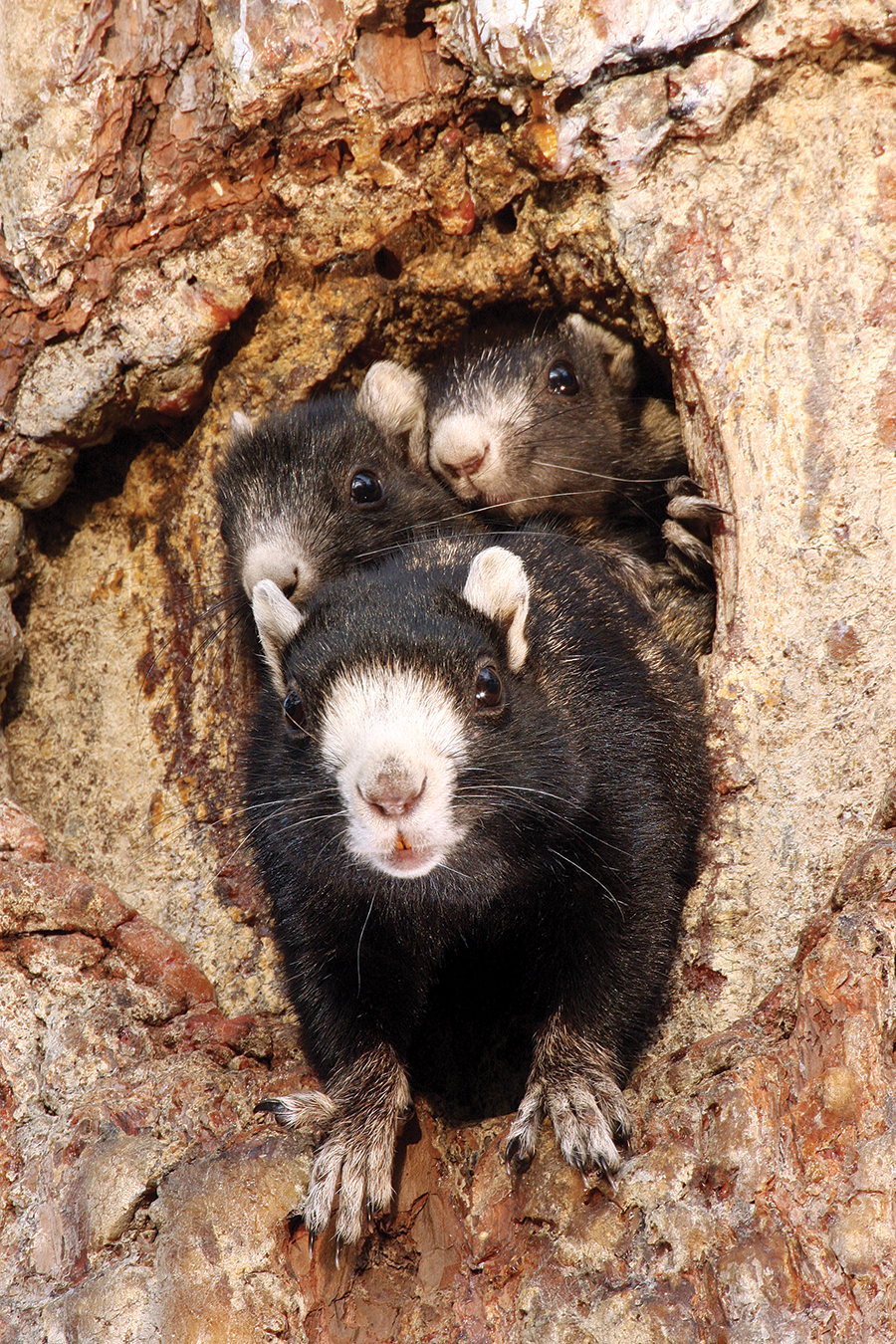
And Todd could have qualified for membership in the hod carriers’ union. “Mostly I was the guy who brought the tools in. He didn’t trust me to lay carpet. Occasionally, he’d let me put pad or glue down. Or a patch. I was patching artificial grass and I laid my finger open and dad was, ‘Just stick it in the bucket of glue and keep working. And don’t get blood on the carpet.’” Todd laughs. “I think he wanted me to inherit the business, but the work was just too hard.”
Sharks seemed easier. Go figure.
“The Undersea World of Jacques Cousteau is what really got me interested in the world’s oceans,” says Pusser. He went to the University of North Carolina-Chapel Hill, stuck his nose into pharmacy, got it bloodied by organic chemistry, and decided being a deck hand on the Calypso (or a facsimile thereof) was preferable to filling prescriptions anywhere on dry land. When he wasn’t putting on his great pumpkin display — an Eagle Springs Halloween tradition that attracted thousands and raised money for the Cameron Boys Home — he started taking summer classes in Morehead City, majored in biology, minored in marine science and specialized in pestering whale biologists at the Smithsonian Institution in the Pacific Northwest. “Three days after graduating I was on a research vessel (the Oregon II) in the Gulf of Mexico doing contract work for the government on a marine mammal survey looking for whales and dolphins,” he says. “I started seeing things like sperm whales. I saw killer whales in the Gulf of Mexico. No one really had any idea killer whales were there at the time. All kinds of dolphins. I was a contract worker for a lab in Mississippi and then I was doing contracts for labs in San Diego and Seattle and Miami. I was going all over the place doing these marine mammal surveys. That’s kind of how I got into the field.” All the time he was taking pictures.
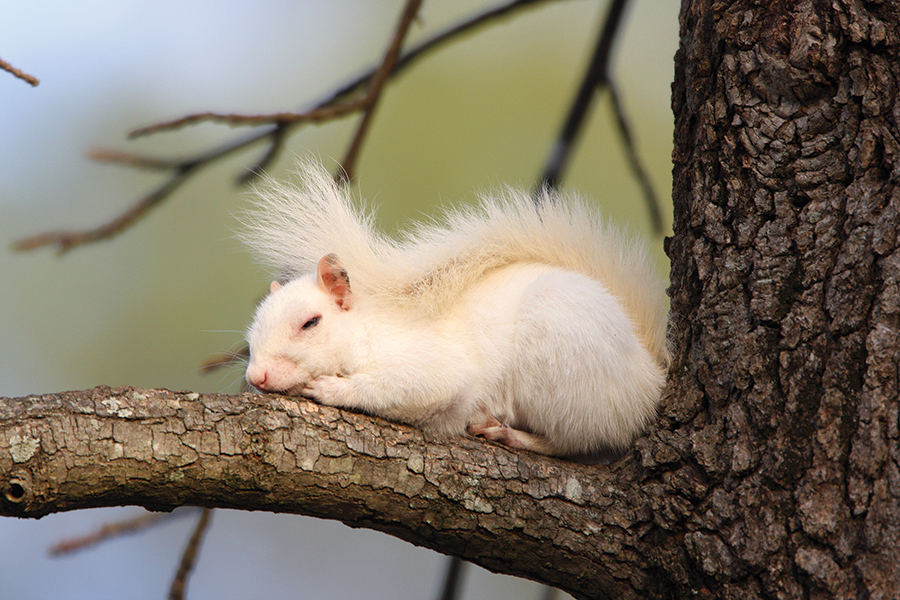
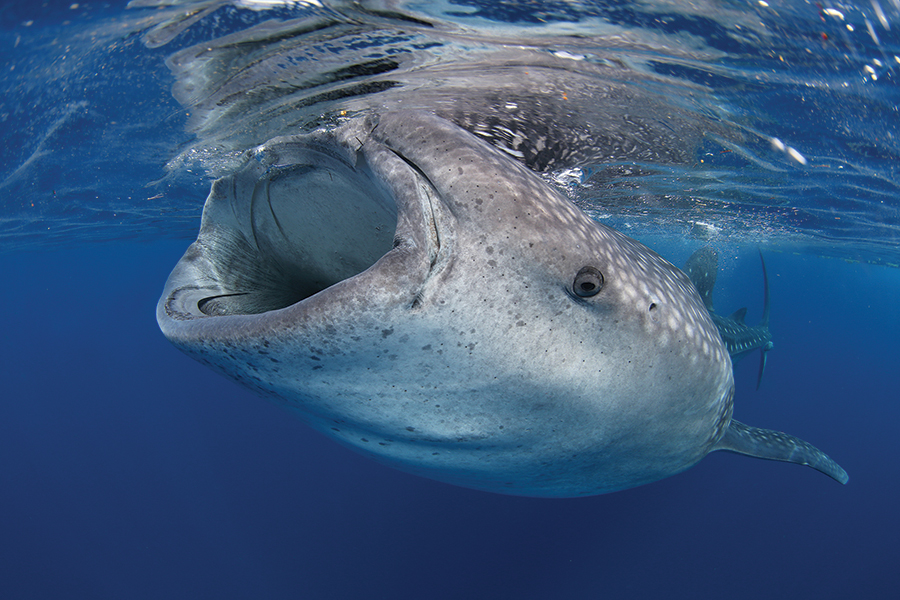
“I was getting photos of animals that had never really been photographed in the wild before, a lot of weird dolphin species,” he says. Other groups began hiring him, including the International Whaling Commission out of the United Kingdom. It was doing surveys in the Antarctic. Pusser figured, hey, why not?
“I’ve made eight trips down there now,” he says. On the first trip for the IWC, he was surveying minke whales. That led to a position as a lecturer for a high-end tour company out of Seattle, defunct after the tourism business fell off a cliff post 9/11, called Society Expeditions. “I was lecturing on their ships taking small groups of people to remote areas of the world. We did this in the Arctic and the Antarctic, the Russian Arctic and the Bearing Sea. Obviously the photo opportunities were incredible,” he says, particularly the Antarctic. “There’s 150,000 penguins, King penguins, that stretch as far as the eye can see. Totally unafraid of people. They never had predators. It’s pretty amazing to be next to those birds.”
Pusser honed his photographic skills the hard way, “trial and error, mostly error,” he says. He mastered his craft in the pre-digital, home-run-or-pop-foul days of 35mm slide film. “I never took any kind of photography class,” he says. “I would study photographers I admired. At the time there was a guy who worked for National Geographic named Flip Nicklin. He was their whale photographer and I really liked his work. And there was another guy named Franz Lanting who was doing a lot of work in jungles and using flash with his photography, which was unheard of with nature photography at the time. It almost had kind of a studio feel to his photos. I really tried to emulate that with my work. I come from a biological background where you studied the behavior of animals and I think that helps with your photography because you’re able to anticipate action or know what an animal is going to do to really kind of capture the personality of the animals, not just a quick snapshot.”
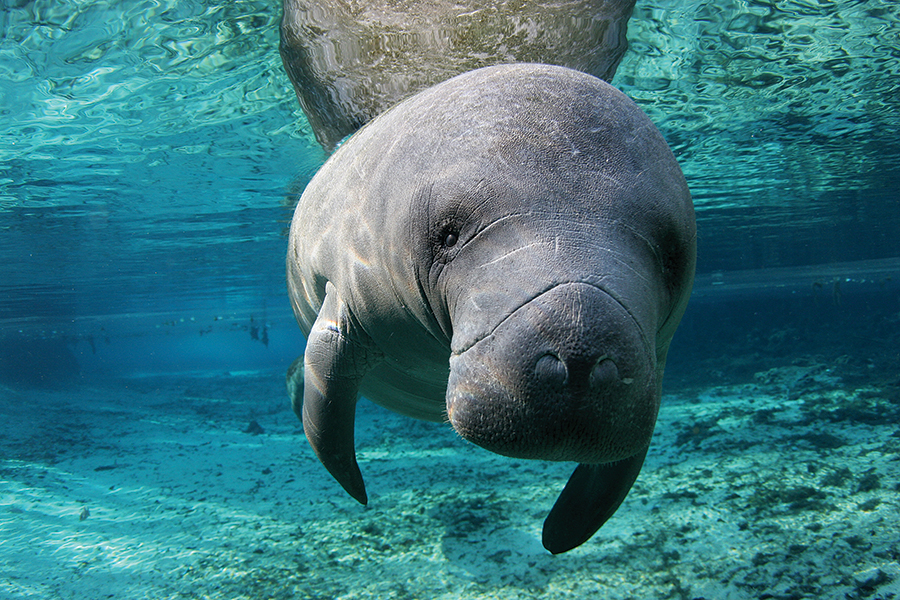
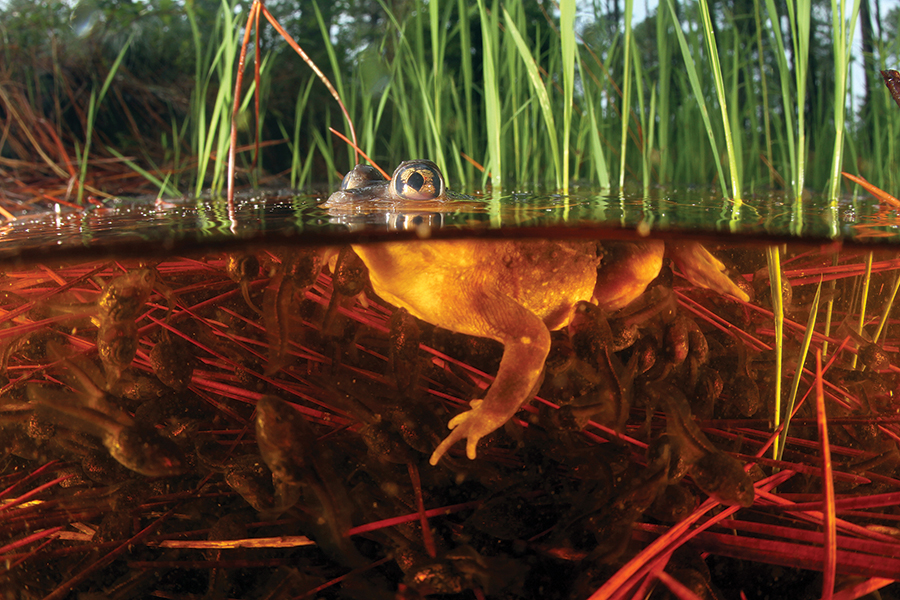
Of course the switch from film to digital was inevitable and, in some cases, desirable. “I was not an easy convert,” says Pusser. “The main reason I started switching to digital was for underwater. Let’s say you’re in the Bahamas and you’re interacting with spotted dolphins — I used to do trips down there almost every year — you have 36 images on your roll of film. You’re there and you’re taking pictures and you hear that last frame and the film rewind in your camera. Get back to the boat. Get out of the water. Dry off. Open the back of your housing. Pop the camera. Pop the film canister out. Reload. You have 30 minutes invested in doing that. By then the behavior you’re trying to photograph is over. Now I stick a 64-gigabyte or 128-gig card in a camera and I’m under water all day. You miss fewer shots.”
So, about those sharks. “One of my favorite shark dives is actually off the coast of North Carolina,” says Pusser. “There are a lot of wrecks off the coast and there’s a species of shark that aggregates there called a sand tiger shark. These are big sharks, 8-10 feet long. They have really large teeth that stick out of their mouths. They’re not afraid of divers. If you sit real still they’ll come right up to you. They’re great subjects to photograph.” How close does he get? “As close as I can,” he says. “If they’re bumping my lens, I’m happy.”
The subject doesn’t have to be a shark or a blue whale to pique Pusser’s interest. “I do tend to try to photograph the more obscure animals that get ignored by other wildlife photographers,” he says. In 2006 he was part of an international team doing a survey on China’s Yangtze River trying to locate an endangered dolphin. The species had been in the river for millions of years but its population had been reduced to a handful by the river’s constant cargo ship traffic and a billion people trying to eke out an existence on its banks — often employing fishing methods lethal to the dolphin. “It was a monotypic genus, meaning it was the only member of that genus. There was nothing else like it anywhere on the planet,” he says. “We spent nearly two months going back and forth on the Yangtze River looking for this dolphin. We declared it extinct in 2006. First dolphin to go extinct at human hand.”
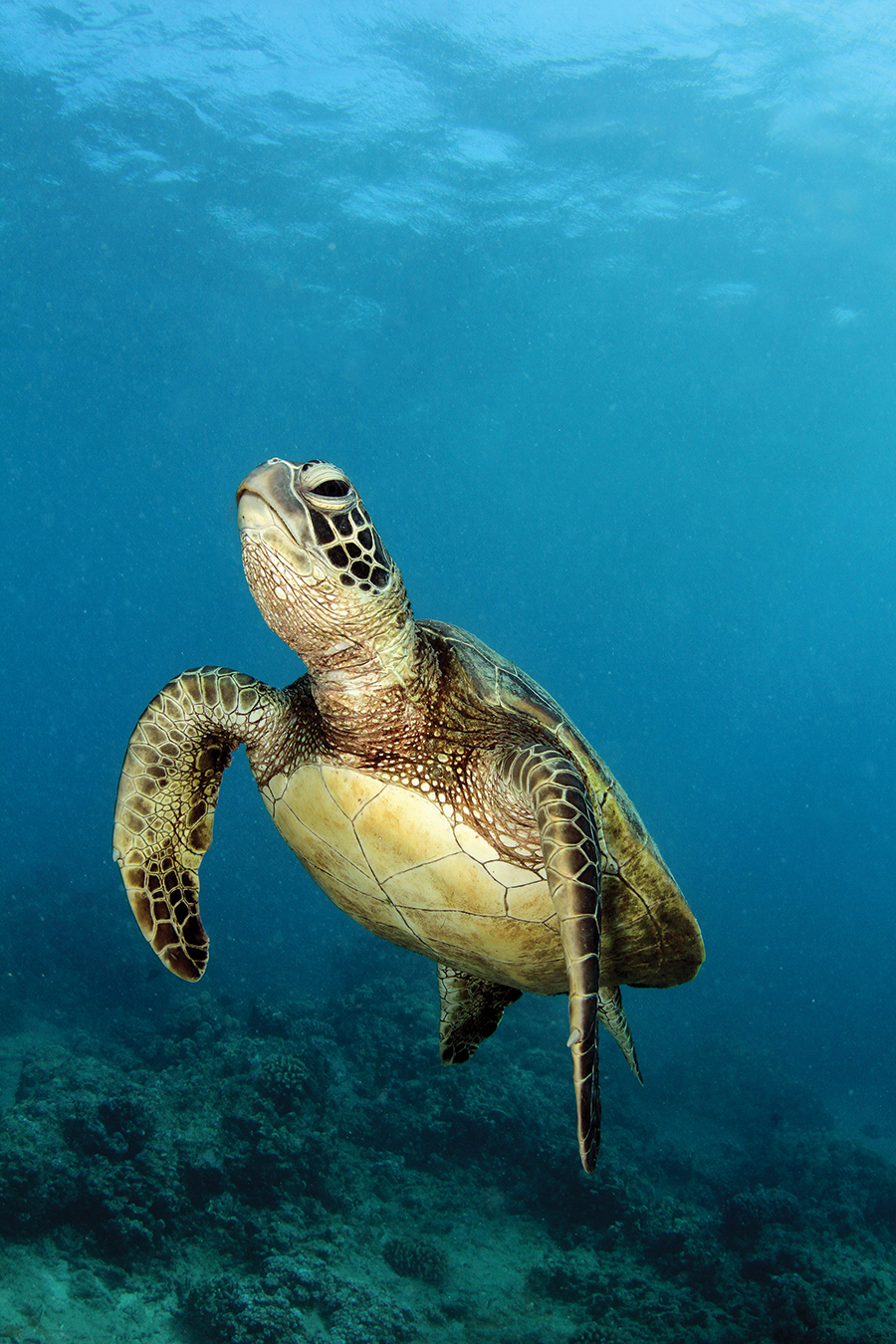
Pusser returned last November from a similar five-week trip to Mexico surveying an endangered porpoise, the vaquita, that’s being killed as by-catch in the northern Sea of Cortez where the Colorado River flows into the Gulf of Baja. “It was kind of a Hail Mary effort by a group out of California to bring them into captivity and breed them,” he says. “There’s a fish, totoaba (a type of croaker), that gets to be like 250 pounds. The fishermen there catch this fish using gill nets and take the swim bladder. Then they send this bladder to China for medicinal purposes. The bladder sells for more than cocaine. So the vaquita, they’re mammals. They swim into a net, get tangled up and drown. The government says you can’t set a gill net but they can come out in an evening, set a net and buy a pick-up truck with a fish bladder. I first did a survey there in ’97, again in 2008 and again in 2015. In 2015 there were like 50 left.” Pusser puts the number closer to 30 now.
“The project managed to capture an adult female but unfortunately she died. The stress of captivity was just too much for her,” says Pusser. “This was a huge blow for the conservation community. I fear the vaquita will soon be added to the long and ever-growing list of species humans have wiped off the planet.”
His camera and his curiosity have taken Pusser to over 30 countries and into every one of the world’s oceans. “Initially, I was only photographing aquatic subjects sharks, whales, dolphins,” he says. “I’d come back here (North Carolina) between projects. I never explored the state, outside of the Sandhills, when I was a kid or a teenager. So, I started networking.
One of the people who entered his orbit was Jeff Beane, the collection manager for herpetology at the North Carolina Museum of Natural Sciences, who became one of Pusser’s closest friends. “He opened my eyes to a lot of things I ignored as a kid. So now I spend a lot of my time documenting biodiversity and conservation issues across the state,” says Pusser who lives in Virginia Beach, Virginia now but remains a regular contributor of both photographs and stories to Wildlife in North Carolina magazine. “We have incredible biodiversity for a temperate region. We have the highest mountains east of the Mississippi; we have a lot of rivers; we have natural lakes; we have the ocean which has the Gulf Stream and the Labrador Current; we’re on a major migration route.”
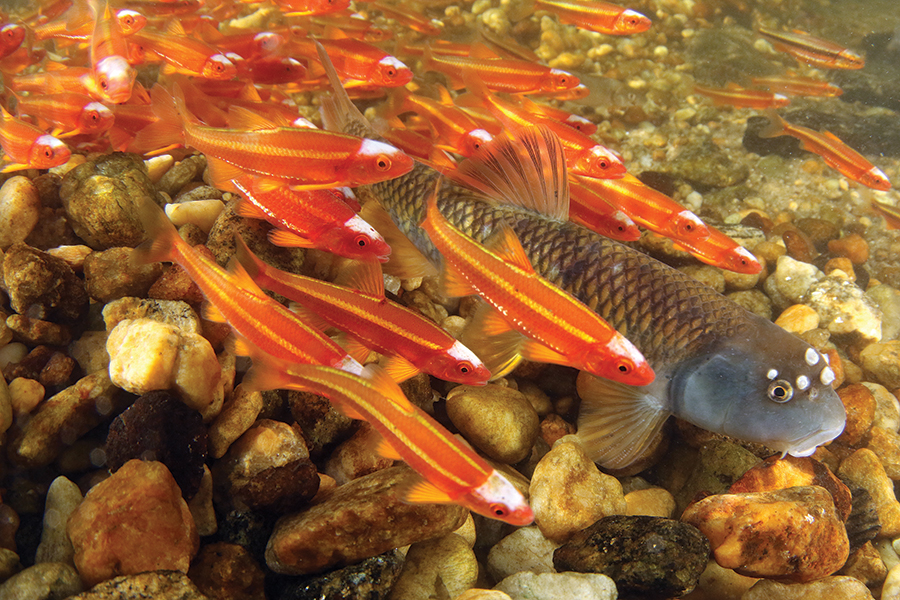
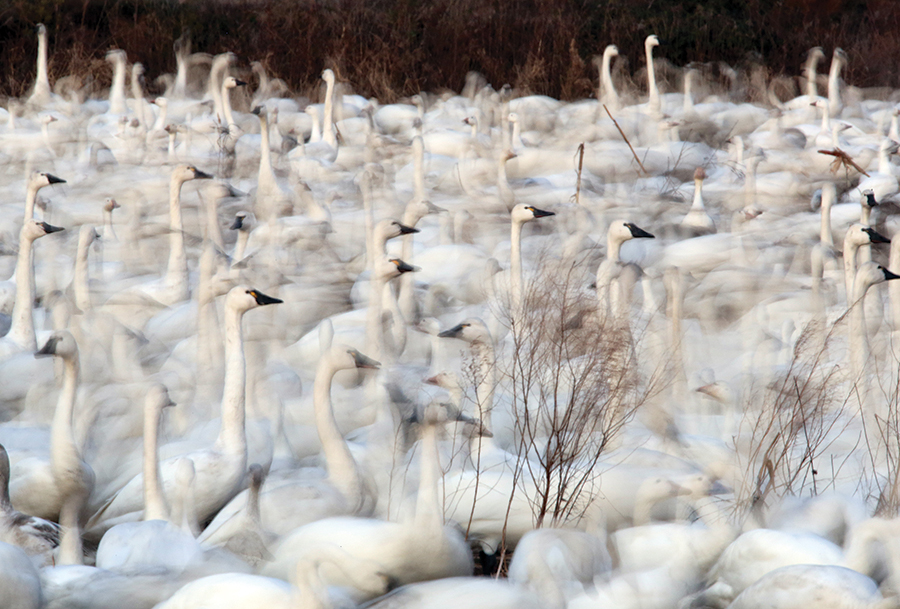
And, as it turns out, he’s just as enthralled with crawfish, chubs or squirrels as blue whales.
“Fox squirrels are probably Todd’s favorite mammal and for years he had never gotten satisfactory photos of one,” says Beane. It wasn’t for a lack of trying. Anytime Pusser saw a fox squirrel, he chased it. “Once he ran through the woods after one in a suit and tie and another time he ran after one in his underwear,” says Beane.
The latter happened when Pusser, in the field with Beane, was trying to photograph an undescribed salamander endemic to the Sandhills and slipped down a muddy creek embankment, sinking in up to his waist. After removing his wet jeans, he saw the squirrel. “I used to say he was always either too overdressed or too underdressed to get good fox squirrel photos,” Beane says — a condition that has since been remedied.
One of Pusser’s writing and photographic projects is scheduled to run as a three-part series in future issues of Wildlife in North Carolina. “There’s this really interesting fish behavior I found out about a few years go and I’ve been trying to document because it’s spectacular,” says Pusser. “In the spring we have two or three species, what are called chubs, that build these nests. If you’ve ever been fly fishing in the mountains, you walk through any creek or stream, you’ll see these mounds of rocks when the water is low. You’ll think maybe people are doing it but these fish, the males, build these nests. They’ll entice a female. They spawn over the nest. They aerate the eggs. They move the rocks around and they guard the nest. But what’s interesting is you have all these minnows and at the right time of year, they light up. Neon yellows, florescent colors. It’s like a corral reef. People don’t associate tropical reef color with a cold mountain stream.”
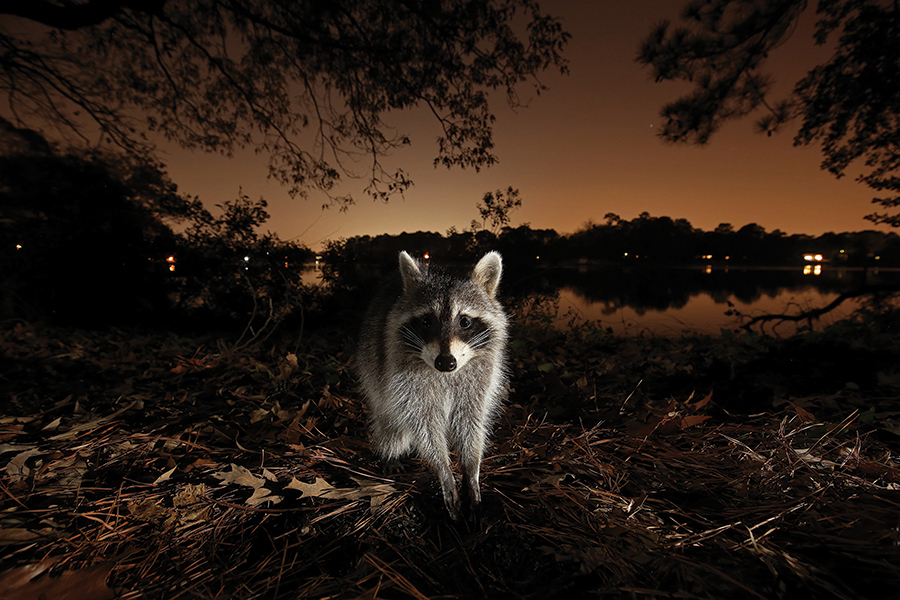
Another one of his passions, picked up from Williamson, is champion trees. “Each state has state champions and they might qualify for a national champion,” says Pusser. “The world’s largest longleaf pine, up until this past year, was on Highway 220 between Candor and Asheboro. It was over 12 feet in circumference and 150 feet high. It snapped during a strong thunderstorm. Now the largest longleaf is somewhere I think in Alabama or Mississippi.” The village of Pinehurst has a Darlington Oak that might be a state champion. “Come outside the Drum and Quill, turn left and you go to the next left,” says Pusser. “It was growing there probably before Pinehurst was created.”
Williamson and Pusser track down champion trees together. “One tree I showed him was a hollow yellow poplar and it’s a national champion,” says Williamson. “I got inside it and he handed me a couple of strobe lights to put on either side to give the interior a little bit of light.”
Shining a little bit of light is Pusser’s specialty. “You don’t have to save the world, just try to get people to appreciate what’s in their backyard,” he says.
It’s a message he enjoys spreading. “There’s a lot of joy in seeing something yourself,” says Beane, “but when you can show it to somebody else who appreciates it, that’s really special.”
And there’s photographic evidence, to boot. PS
For more information visit Todd Pusser’s website at: https://toddpusser.photoshelter.com/
Jim Moriarty is senior editor of PineStraw and can be reached at jjmpinestraw@gmail.com.





